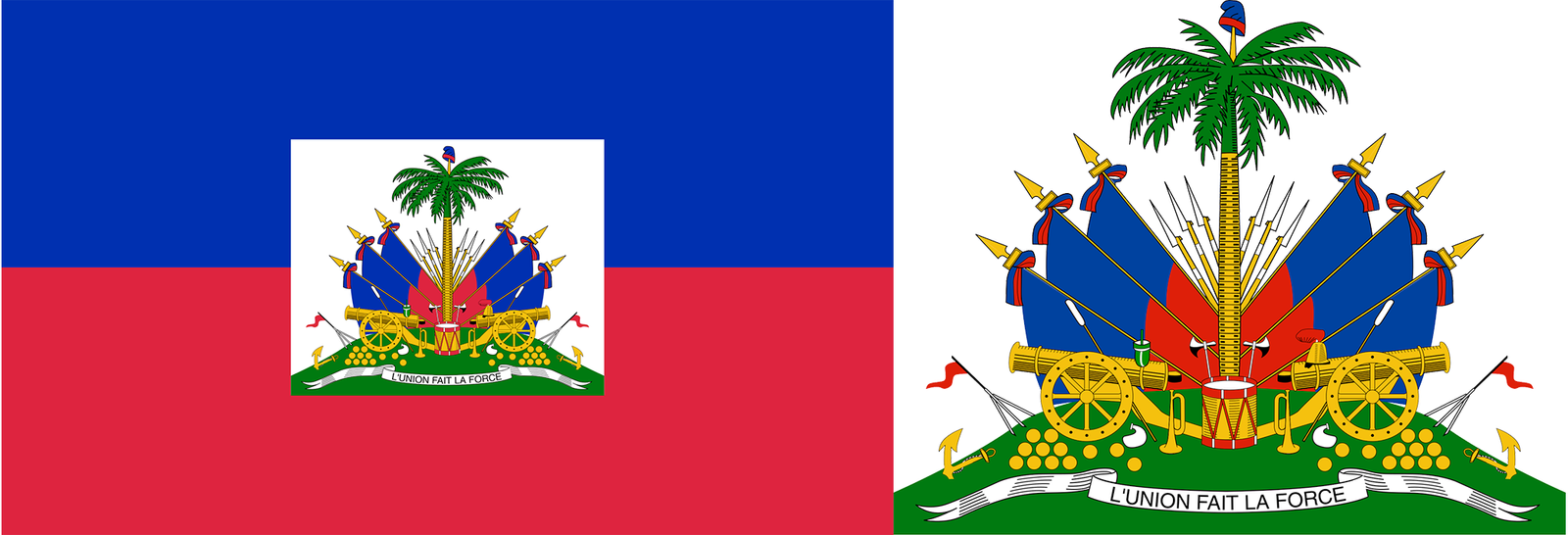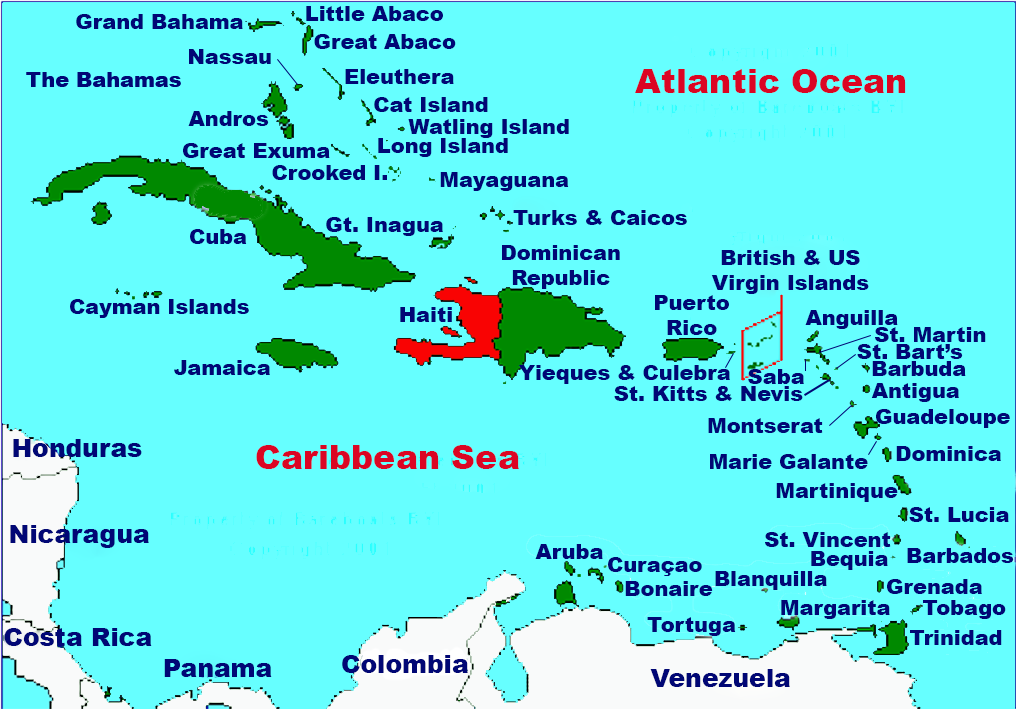FabulousFusionFood's Haitian Recipes Home Page
 The flag of Haiti (left) and the coat of arms of Haiti (right).
The flag of Haiti (left) and the coat of arms of Haiti (right).
Welcome to the summary page for FabulousFusionFood's Haitian recipes, part of the Caribbean. This page provides links to all the Haitian recipes presented on this site, with 16 recipes in total.
This is a continuation of an entire series of pages that will, I hope, allow my visitors to better navigate this site. As well as displaying recipes by name, country and region of origin I am now planning a whole series of pages where recipes can be located by meal type and main ingredient. This page gives a listing of all the Indian recipes added to this site.
Haiti is a country on the island of Hispaniola in the Caribbean Sea (which it shares with the Dominican Republic). Haiti is the third largest country in the Caribbean, and with an estimated population of 11.4 million, is the most populous Caribbean country. The capital and largest city is Port-au-Prince.
Haitian cuisine is a Creole cuisine that originates from a blend of several culinary styles that populated the western portion of the island of Hispaniola, namely African, French, indigenous Taíno, Spanish, and Arab influences. Haiti is famous for its creole cuisine (related to Cajun cuisine), and its soup joumou.
Haiti, officially the Republic of Haiti (République d'Haïti in French and Repiblik d'Ayiti in Haitian Creole) is a country on the island of Hispaniola in the Caribbean Sea, east of Cuba and Jamaica, and south of the Bahamas. It occupies the western three-eighths of the island, which it shares with the Dominican Republic. Haiti is the third largest country in the Caribbean, and with an estimated population of 11.4 million, is the most populous Caribbean country. The capital and largest city is Port-au-Prince.
 Location of Haiti in the Caribbean with the land mass of
Location of Haiti in the Caribbean with the land mass of
Haiti on Hispaniola picked out in red.Haiti was originally inhabited by the Taíno people. In 1492, Christopher Columbus established the first European settlement in the Americas, La Navidad, on its northeastern coast. The island was part of the Spanish Empire until 1697, when the western portion was ceded to France and became Saint-Domingue, dominated by sugarcane plantations worked by enslaved Africans. The 1791–1804 Haitian Revolution made Haiti the first sovereign state in the Caribbean, the second republic in the Americas, the first country in the Americas to officially abolish slavery, and the only country in history established by a slave revolt. The 19th century saw political instability, international isolation, debt to France, and failed invasions of the Dominican Republic, including a costly war. U.S. forces occupied Haiti from 1915 to 1934, followed by dictatorial rule of the Duvalier family (1957–1986). After a coup d'état in 2004, the United Nations intervened. In the 2010s, a catastrophic earthquake and a deadly cholera outbreak devastated the country.
Etymology: Haiti (also earlier Hayti) comes from the indigenous Taíno language and means 'land of high mountains'; it was the native name for the entire island of Hispaniola. The name was restored by Haitian revolutionary Jean-Jacques Dessalines as the official name of independent Saint-Domingue, as a tribute to the Amerindian predecessors.
In French, the ï in Haïti has a diacritical mark (used to show that the second vowel is pronounced separately, as in the word naïve), while the H is silent. (In English, this rule for the pronunciation is often disregarded, thus the spelling Haiti is used.) There are different anglicizations for its pronunciation such as HIGH-ti, high-EE-ti and haa-EE-ti, which are still in use, but HAY-ti is the most widespread and best-established. In French, Haiti's nickname means the 'Pearl of the Antilles' (La Perle des Antilles) because of both its natural beauty and the amount of wealth it accumulated for the Kingdom of France. In Haitian Creole, it is spelled and pronounced with a y but no H: Ayiti. Another theory on the name Haiti is its origin in African tradition; in Fon language, one of the most spoken by the bossales (Haitians born in Africa), Ayiti-Tomè means: 'From nowadays this land is our land'.
In the Haitian community the country has multiple nicknames: Ayiti-Toma (as its origin in Ayiti Tomè), Ayiti-Cheri (Ayiti my Darling), Tè-Desalin (Dessalines' Land) or Lakay (Home).
This is a continuation of an entire series of pages that will, I hope, allow my visitors to better navigate this site. As well as displaying recipes by name, country and region of origin I am now planning a whole series of pages where recipes can be located by meal type and main ingredient. This page gives a listing of all the Indian recipes added to this site.
Haiti is a country on the island of Hispaniola in the Caribbean Sea (which it shares with the Dominican Republic). Haiti is the third largest country in the Caribbean, and with an estimated population of 11.4 million, is the most populous Caribbean country. The capital and largest city is Port-au-Prince.
Haitian cuisine is a Creole cuisine that originates from a blend of several culinary styles that populated the western portion of the island of Hispaniola, namely African, French, indigenous Taíno, Spanish, and Arab influences. Haiti is famous for its creole cuisine (related to Cajun cuisine), and its soup joumou.
Haiti, officially the Republic of Haiti (République d'Haïti in French and Repiblik d'Ayiti in Haitian Creole) is a country on the island of Hispaniola in the Caribbean Sea, east of Cuba and Jamaica, and south of the Bahamas. It occupies the western three-eighths of the island, which it shares with the Dominican Republic. Haiti is the third largest country in the Caribbean, and with an estimated population of 11.4 million, is the most populous Caribbean country. The capital and largest city is Port-au-Prince.
 Location of Haiti in the Caribbean with the land mass of
Location of Haiti in the Caribbean with the land mass ofHaiti on Hispaniola picked out in red.
Etymology: Haiti (also earlier Hayti) comes from the indigenous Taíno language and means 'land of high mountains'; it was the native name for the entire island of Hispaniola. The name was restored by Haitian revolutionary Jean-Jacques Dessalines as the official name of independent Saint-Domingue, as a tribute to the Amerindian predecessors.
In French, the ï in Haïti has a diacritical mark (used to show that the second vowel is pronounced separately, as in the word naïve), while the H is silent. (In English, this rule for the pronunciation is often disregarded, thus the spelling Haiti is used.) There are different anglicizations for its pronunciation such as HIGH-ti, high-EE-ti and haa-EE-ti, which are still in use, but HAY-ti is the most widespread and best-established. In French, Haiti's nickname means the 'Pearl of the Antilles' (La Perle des Antilles) because of both its natural beauty and the amount of wealth it accumulated for the Kingdom of France. In Haitian Creole, it is spelled and pronounced with a y but no H: Ayiti. Another theory on the name Haiti is its origin in African tradition; in Fon language, one of the most spoken by the bossales (Haitians born in Africa), Ayiti-Tomè means: 'From nowadays this land is our land'.
In the Haitian community the country has multiple nicknames: Ayiti-Toma (as its origin in Ayiti Tomè), Ayiti-Cheri (Ayiti my Darling), Tè-Desalin (Dessalines' Land) or Lakay (Home).
Haitian Cuisine:
Haitian cuisine is a Creole cuisine that originates from a blend of several culinary styles that populated the western portion of the island of Hispaniola, namely African, French, indigenous Taíno, Spanish, and Arab influences. Haitian cuisine has some similarities with 'criollo' (Spanish for 'creole') cooking and similar to the rest of the Caribbean, but differs in several ways from its regional counterparts. Flavours are bold and spicy demonstrating African and French influences, with notable derivatives coming from native Taíno and Spanish techniques. Levantine influences have made their way into the mainstream culture, due to an Arab migration over the years forming a community of shared Arab descent. Years of adaptation have led to these cuisines to merge into Haitian cuisine.The alphabetical list of all the Haitian recipes on this site follows, (limited to 100 recipes per page). There are 16 recipes in total:
Page 1 of 1
| Bananes Pessés (Refried Plantains) Origin: Haiti | Goat and Aubergine Kebabs Origin: Haiti | Sos Ti-malice (Ti-malice Sauce) Origin: Haiti |
| Blan Manje Origin: Haiti | Griots Origin: Haiti | Soup Joumou (Haitian Squash Soup) Origin: Haiti |
| Diri Ak Pwa (Haitian Rice and Beans) Origin: Haiti | Pikliz Origin: Haiti | Tarte a L'oingon (Onion Tart) Origin: Haiti |
| Epis (Haitian Green Seasoning) Origin: Haiti | Poule nas sos (Chicken in Sauce) Origin: Haiti | Tostones (Fried Plantains) Origin: Haiti |
| Gateau Ayisyen (Haitian Cake) Origin: Haiti | Riz Dion (Rice and Mushrooms) Origin: Haiti | |
| Gateau Ayisyen Zoranj (Haitian Orange Cake) Origin: Haiti | Riz et Pois Collés (Haitian Rice with Peas) Origin: Haiti |
Page 1 of 1